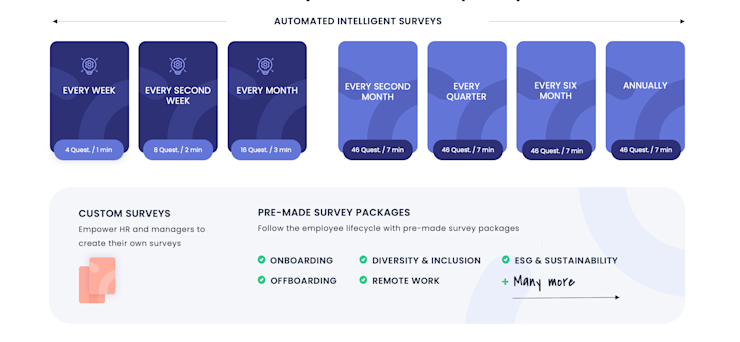Employee satisfaction surveys are an essential tool for HR managers to measure and increase employee engagement, performance, and overall workplace morale.
However, it can be difficult to decide which questions to include in an employee satisfaction survey - from simple 'yes or no' queries, through to open-ended ones concerning rewards and recognition.
In this blog post, we'll take a look at the various kinds of questions you should include in your surveys; including management-related queries, reward & recognition inquiries, communication issues, benefits topics, onboarding considerations as well as blue-collar and restaurant-specific items.
Keep reading for some insights into how best gauge the level of job contentment among staff.
What is an employee satisfaction survey?
An employee satisfaction survey is a tool used to measure how content and fulfilled employees are in their job roles. It is designed to gauge the overall level of job satisfaction, morale, and engagement among staff members.
Think of it like a thermometer for the organisational climate. Indicating whether the workplace environment is hot and vibrant, warm and comfortable, or cold and frigid.
Questions posed in the survey are meant to determine what elements of the workplace are satisfactory and which could be enhanced.
Your organisation is measuring KPIs for most of the important areas in real-time, such as finance, sales, and marketing - so why not use the same approach for your people? You can do that with an Eletive’s intelligent pulse survey.
How many questions are in an employee satisfaction survey?
The number of questions in an employee satisfaction survey depends on a number of factors, such as;
the purpose of the survye
the depth of the survey
the frequency of survey sendouts
Surveys can range from broad topics such as job satisfaction to more specific topics like customer service or workplace safety. When creating an employee satisfaction survey, it is important to ask questions that are relevant to your organisation’s needs and goals.
Employees reactions to their work can be probed with a range of query formats, such as 'yes/no', rating statements on a scale, and open-ended questions . To better understand the effectiveness of these different types of survey questions, it is important to consider their respective advantages and disadvantages. For more in-depth insights around different survey question formats, recommend reading our article: Employee engagement survey questions – what to ask and why

To be able to measure progress, spot trends, and work in a data-driven way, it's important to not constantly change the content of your employee satisfaction surveys. Included in the Eletive platform is a science-based plug-and-play question battery, that allows you to monitor and track employee satisfaction and engagement over time. Advanced survey intelligence helps you automate and tailor the survey frequencies according to your organisational needs.
This means you can, for example, send out monthly surveys to some parts of your organisation, and weekly to others. Instead of sending out the same fixed question battery every time, adaptive algorithms and machine learning create a more dynamic survey sequence. This means that your employees will not receive the same questions again and again. Instead, the questions they receive will depend on their answers in the last survey. However, over the course of 6 months, all employees will have received all questions.
This approach allows the system to spot negative trends and alert managers and HR quickly that there is an issue, while at the same time removing the risk of survey fatigue that sometimes comes with surveys that are too repetitive.
Yes or no employee satisfaction questions VS open-ended vs rating scales
When it comes to employee satisfaction surveys, there are four main types of questions: yes or no, open-ended questions, closed-ended questions, and eNPS (Employee Net Promoter Score).
Yes or no questions are straightforward, and require a simple answer that can be quickly analysed. Open-ended questions offer the opportunity for employees to provide additional feedback and insight into their experiences. Rating scales provide more nuance and allow you to track trends and identify shifts in the level of employee satisfaction.
Yes or no questions
These questions are great for quickly gathering information about employee engagement levels in a given area.
HR personnel may inquire, "Are you content with your job right now?" to get an idea of the engagement level of their staff without dedicating too much time to scrutinising the answers.
However, these types of questions don’t offer much nuance. To allow for better follow-up and further discussion on why an employee may have answered one way or another, it can be a good idea to add the option to leave comments.
Open-ended questions
Open-ended questions are broad and allow the respondent to answer in free text. These questions offer HR managers valuable insights into what motivates and drives their workforce, as well as which areas of the organisation require attention.
Through these inquiries, HR personnel and managers can gain an understanding of how to best foster a positive working environment for their employees.
💡 Pro tip: Interpreting large amounts of free-text answers is time-consuming. Eletive’s Listening AI feature helps analyse, understand and visualise free-text answers to open-ended questions at scale.
Closed-ended questions
Closed-ended questions provide a question prompt and ask respondents to choose from a list of possible responses or rate a statement on a scale. This type of questions form the basis in the science-based question battery that is included in the Eletive platform. This question battery is designed to measure all the important drivers of employee engagement.
💡 Pro tip: Eletive’s machine-learning and smart algorithms help you gather feedback and drive engagement with less admin, compared to traditional surveys where someone manually has to choose and compile questions every time the surveys go out.
eNPS (Net Promoter Score)
The purpose of the Employer Net Promoter Score, or eNPS, is to help employers measure employee satisfaction within their organisations. The eNPS is based on one single question:
”How likely is it that you would recommend your employer to a friend or acquaintance?”
The answer options range from 0 to 10, where 10 means “Extremely likely” and 0 means “Not at all likely”. The responses are then divided into Promoters (9, 10), Passives (7,8), and Detractors (0-6).

Benefits of employee satisfaction surveys
Satisfaction surveys give your employees a voice
When employers act swiftly upon the employee feedback in the surveys, employees will notice the actions taken to improve their satisfaction and that their voices are heard and valued at the company. This in turn improves employee motivation at the company and helps to increase productivity.
Satisfied employees lead to satisfied customers
Who benefits from engaged workers that are willing to go the extra mile?
That's right, the customers.
Customers' perception of the service they are provided with has an influence on overall customer satisfaction. That means that customer satisfaction is a consequence of employee satisfaction and that those two concepts go hand in hand.
Employee satisfaction surveys reduce employee turnover
By managing employee satisfaction and keeping workers engaged and motivated companies can prolong the employee journey and reduce turnover. Reducing employee turnover saves employers both time and money in recruiting and onboarding new inexperienced staff, while directly impacting the profitability and productivity of the company.
Satisfied employees become ambassadors/advocates
Happy employees become great marketers for your company. When using Eöetove's employee satisfaction surveys, you can also measure the eNPS of the employees in the company. If the eNPS is high, chances are that the workers are doing a fair bit of marketing for your company, for free!
This is great in more than one way. Satisfied employees are more likely to share company content on their personal social media pages during out-of-office hours and talk favourably about their workplace, which will increase the chances of attracting both new customers and new, top-tier talent that can help propel your company forward.
Related reading: 5 Benefits of Employee Engagement
Employee satisfaction survey questions
In this section, we’ll have a look at employee satisfaction survey questions for :
Management
Rewards and recognition
Communication
Benefits
Onboarding
Blue collar workers
Restaurants
Feel free to skip to the section that appeals to you the most by clicking on the links above.
💡 Pro tip: Implementing these survey questions and adding them to the regular standard surveys is easy with Eletive’s custom survey feature.
Management employee satisfaction survey questions
Management staff contentment polls are an excellent means of assessing the performance of managers and their capability to interact with personnel.
These surveys can help HR professionals gain insight into how well management is meeting the needs of its staff.
Yes or no employee satisfaction questions can be used to gauge an overall level of satisfaction with management.
Example yes/no questions to use as a starting point:
Do you feel that your manager recognises and values the unique strengths and talents you bring to the team?
Has your manager provided you with the resources and support necessary to meet your job responsibilities and expectations?
Have you received actionable and specific feedback from your manager that has helped you improve your work?
Do you feel that your manager creates a safe and approachable environment that encourages open communication?
Has your manager provided you with opportunities for professional growth and development that align with your career goals?
Have you felt appreciated and recognized by your manager for your contributions to the team?
Does your manager communicate company policies and procedures in a way that is easy to understand and follow?
Does your manager actively foster a team culture that promotes positivity, collaboration, and inclusivity?
Has your manager demonstrated a willingness to consider and act on your ideas and suggestions?
Does your manager take ownership of their mistakes and work to make things right?
Open-ended questions provide a more detailed look at how employees view their managers.
Asking specific questions about communication styles, problem-solving abilities, and decision-making processes can give HR teams valuable feedback on how effective management is in these areas.

Example open-ended questions:
How would you describe the leadership style of your manager? How does this style impact your work and your team?
What specific actions or behaviours has your manager exhibited that have positively impacted your work or team dynamics?
What specific actions or behaviours has your manager exhibited that have negatively impacted your work or team dynamics?
How has your manager supported your professional development? In what ways could they improve in this area?
How has your manager fostered a positive team culture? Are there any areas for improvement?
How has your manager handled conflicts or difficult situations within the team? Was this handled effectively? Why or why not?
Have you received adequate recognition and appreciation from your manager? If not, how could this be improved?
How does your manager communicate changes in company policies or procedures? Is there room for improvement in this area?
How does your manager foster a sense of inclusivity and diversity within the team? Is there room for improvement in this area?
Do you feel comfortable approaching your manager with questions or concerns? If not, what could be done to improve this dynamic?
The management employee satisfaction survey questions are a great way to measure the effectiveness of leadership and how employees feel about their supervisors. To further understand how to motivate and retain your staff, it is important to explore reward and recognition employee satisfaction survey questions.
Reward and recognition employee satisfaction survey questions
Reward and recognition employee satisfaction survey questions should focus on whether or not employees feel valued for their contributions.
Employee contentment assessments can be a potent means of evaluating and augmenting involvement, proficiency, and enthusiasm.
A good survey should include questions about rewards and recognition to get an accurate picture of how employees feel valued by their employer.
Example questions:
Do you receive adequate recognition for work done above expectations?
Does upper management acknowledge individual achievements regularly enough?
Do you feel adequately rewarded for your efforts?
Are you aware of any incentive programs available at your workplace?
Are you content with the amount of commendation displayed by your boss or administrator?
Does your current salary reflect market value for similar positions within this industry?
By measuring employee satisfaction related to reward and recognition, organisations can gain valuable insights into the effectiveness of their current strategies.
Moving on, let's explore how communication impacts employee satisfaction by examining survey questions in this area.
Communication employee satisfaction survey questions
To gain a better understanding of the effectiveness of communication between managers, employees and teams, HR should assess both formal (e.g. e-mail, intranet) and informal (e.g. face-to-face meetings) methods in employee satisfaction surveys.
💡 Pro tip: In the Eletive platform, "Feedback and Communication" is one of the 11 main drivers of employee engagement that are covered by our standard plug-and-play question battery. If you want to, you can add more questions to the regular surveys, or send out custom surveys to cover specific areas.
Example questions:
Are there any impediments blocking rapid responses from supervisors?
Do all participants have equivalent access to pertinent information?
Is there enough two-way dialogue among groups?
How satisfied are you with the frequency of communication from management?
Do you feel like your opinions and ideas are taken into consideration when making decisions?
Are team meetings productive and efficient?
Is there enough transparency between management and staff members?
Are issues addressed quickly by management or do they linger unresolved for too long?
Does upper-level management regularly communicate expectations clearly to all staff members?
These will help identify any possible problems related to clarity of information sharing or lack thereof from either side(s).
Interaction is an indispensable piece of any productive business. It’s essential to ensure that employees feel heard and understood, as well as have the opportunity to provide feedback.
Employee satisfaction survey questions about benefits
Employee satisfaction survey questions about benefits should evaluate if employees believe they're receiving fair compensation packages relative to industry standards, including bonuses, insurance coverage, vacation time etc
Example questions:
Are benefits packages competitive compared with other companies in this sector?
Would additional incentives motivate higher performance levels?
Is salary commensurate with job responsibilities?
What opinion do you possess concerning the health insurance benefits presented by your job?
Are there any further advantages that would make your job more gratifying?
What do you think could be improved or added regarding the current benefit offerings?
Do you possess the necessary knowledge to maximise your advantages?
Is there anything else that should be included in the company’s benefit package?
Do you feel like the current retirement plan options meet your needs adequately?
Benefits are an important factor in creating job satisfaction, so it is essential to include questions about benefits when conducting an employee satisfaction survey.
These types of questions can help employers gain valuable feedback from their employees on what they appreciate most (or least) about their benefits packages. Asking these open-ended questions allows for honest answers and provides employers with insight into how they can improve upon existing policies or add new ones if needed.
Asking for employee feedback on benefits packages can also foster a culture of appreciation, resulting in higher engagement and efficiency within the workplace.

Onboarding satisfaction survey questions
Onboarding satisfaction survey questions should seek feedback from new hires who've gone through onboarding programs recently – this type of data can indicate where improvements could be made so that future onboarding experiences are smoother transitions into working life at the organisation.
Example questions:
Was orientation clear & concise?
Did training sessions meet expectations?
Were tasks delegated appropriately during onboarding process
Onboarding satisfaction surveys provide insight into how new hires feel about their onboarding experience, which can help identify areas of improvement.
The best questions for an onboarding survey should be tailored to the company’s specific needs, but there are some common topics that should always be included.
Questions related to the overall onboarding process:
These give a general overview of how successful it was in meeting expectations and helping employees transition into their new roles.
Examples questions:
What is your assessment of the overall experience?
Which elements were most advantageous during your induction?
Did you feel like your manager kept you informed throughout the entire onboarding period?
Was there anything missing from your orientation materials that would have been useful?
Questions about onboarding resources:
Asking questions related to available resources can reveal if employees had access to everything they needed during their first few weeks on the job.
Examples questions:
Were all necessary tools made available on day one?
Were any additional training sessions offered after orientation ended?
It is essential that employers and employees comprehend what their roles entail, so inquiring about this matter can ensure everybody has a mutual understanding.
Example questions:
Do you understand what is expected of you in this role?
Do you feel like management has clearly communicated job responsibilities?
HR managers can gain an understanding of the success rate of their onboarding processes and any potential adjustments by incorporating such queries in an employee satisfaction survey.
This can help them identify areas for improvement and ensure that employees have the resources they need to succeed in their roles.
Moving on, blue-collar employee satisfaction survey questions can help employers understand what motivates and satisfies these workers so they can be better supported in their work.

Blue collar employee satisfaction survey questions
Questions must be tailored to the specific blue-collar job being surveyed. For example, questions about physical safety may be relevant for construction workers while warehouse staff may have different needs related to their environment or equipment used on the job.
It is also important to consider cultural differences when creating survey questions as blue-collar jobs often employ people from diverse backgrounds with varying perspectives on work satisfaction.
Recommended reading: How to engage blue-collar workers with employee surveys
Example Questions:
How satisfied are you with the safety measures in place at our workplace?
Do you feel that you have access to the equipment and tools needed to perform your job effectively?
How satisfied are you with the cleanliness and maintenance of our workplace?
Do you feel that you receive enough training to perform your job effectively?
How satisfied are you with your work schedule?

Restaurant employee satisfaction survey questions
Restaurant employee satisfaction surveys typically probe deeper into customer service aspects since restaurants rely heavily upon customer experience ratings.
Example questions:
Is staff knowledgeable about menu items?
Is cleanliness maintained consistently throughout the restaurant?
Are customers greeted promptly upon arrival?
When it comes to restaurant employee satisfaction surveys, there are a variety of questions that can be asked in order to gain an accurate assessment of the employees’ feelings as well.
Questions should focus on areas such as job satisfaction, pay and benefits, communication with management, rewards and recognition programs, training opportunities, career development potentials and overall workplace environment.
Example questions:
How satisfied are you with your current position?
Is the remuneration received for duties performed equitable?
Are there any modifications or advancements desired in terms of remuneration or advantages?
Is communication between management and staff adequate?
Do rewards and recognition programs motivate employees to perform better?
Does this restaurant provide enough training opportunities for its staff members?
Are there any career development prospects available within this organisation?
How would you rate the overall atmosphere of the workplace ?
Are there any other comments or suggestions about working at this restaurant that we should consider ?
How to create an employee satisfaction survey report
Creating an employee satisfaction survey report is an essential task for any HR professional or manager looking to improve the employee experience within their organisation.
Traditionally, this process involved manually compiling and analysing the data collected from the survey responses.
The first step in creating a traditional employee satisfaction survey report is to compile the data collected from the survey into a spreadsheet or database. Next, the data is analysed to identify trends, patterns, and areas for improvement. Finally, the findings are presented in a report format that includes charts, graphs, and summaries of the data.
While this traditional approach can be effective, it is also time-consuming and can be prone to errors. Manually entering and analysing data is a tedious and time-consuming task that can take hours, if not days, to complete. Additionally, the process of manually creating reports can be prone to human errors and inconsistencies in the data analysis.
Fortunately, there is a better alternative. HR professionals and managers can utilise Eletive’s real time reports feature to automate the data collection, analysis, and reporting process. Our one-click export feature allows you to turn your real-time reports into beautiful PowerPoint presentations ready to be shared in meetings.
Conclusion
With the right questions, you can gain valuable insights into how employees feel about their job roles, rewards and recognition systems, communication channels, benefits packages, onboarding processes etc.
By understanding what your staff think of these areas in detail you will be able to identify any issues that need addressing or areas where improvements could be made - ultimately helping make sure everyone is happy with their working environment.
Take control of your employee engagement and performance today by utilising Eletive's powerful survey tools to measure satisfaction levels. Our solutions will help you identify areas for improvement and create a better workplace environment for everyone.
FAQs in relation to employee satisfaction survey questions
What should I ask in an employee satisfaction survey?
Employee satisfaction surveys should ask questions that measure employee engagement, job satisfaction, and performance. Questions such as assessing satisfaction with role, value from manager/colleagues, obstacles to desired results and motivation for good job performance should be asked in employee satisfaction surveys. Additionally, open-ended questions can provide further insight into employee sentiment.
Recommended reading: Employee engagement survey questions – what to ask and why
How effective are employee satisfaction surveys?
Employee satisfaction questionnaires offer an efficient way of gauging employee involvement and execution. Surveys of staff satisfaction can give valuable insight into the sentiments, views, and encounters of workers within a business. When properly designed and implemented, these surveys help to identify areas that need improvement in order to increase employee morale and productivity. Surveys also offer an opportunity for employers to recognise their successes as well as areas where they may need to focus more attention or resources. Ultimately, effective use of satisfaction surveys is key in helping organisations maximise their potential by optimising the workplace environment for success.

























